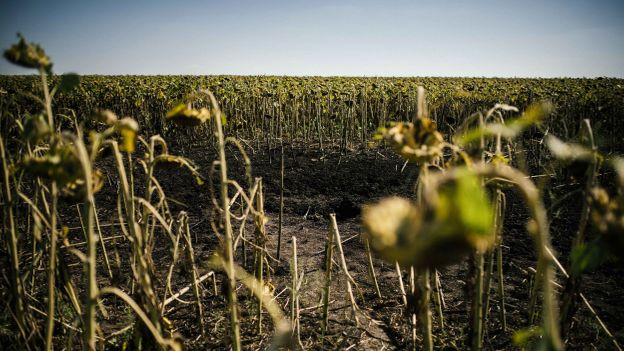
The toxic legacy of the Ukraine war
[ad_1]
Features correspondent
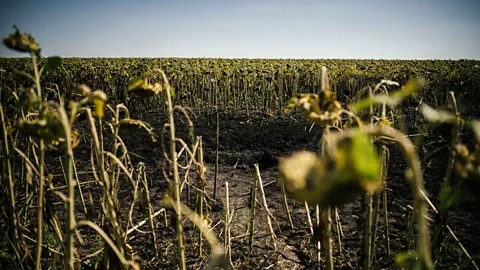 Dimitar Dilkoff/Getty Images
Dimitar Dilkoff/Getty ImagesRussia’s invasion is leaving a toxic trace on Ukrainian soil, contaminating crops and posing a serious long-term risk to human health.
On 6 June, satellite images captured hundreds of craters made by artillery shells and a 40m-wide (131 ft) hole left by a bomb in fields around the village of Dovhenke, in eastern Ukraine. It is just one site left scarred by Russia’s invasion of its neighbour. And as the war continues to wreak a devastating humanitarian toll on the people caught up in the fighting, the conflict is leaving a far less obvious, toxic legacy on the land itself.
The Ukrainian government has asked the United Nations Environment Programme (UNEP) to help it assess the environmental damage being done by the conflict. Preliminary monitoring by the agency and its partners suggest that urban and rural landscapes could be left with a “toxic legacy for generations to come“.
Attacks across Ukraine have already resulted in the destruction of chemical factories or waste storage facilities, which is leading to a cocktail of pollution issues. The latest figures collated in January by the UNEP estimate that 618 industrial or critical infrastructure sites have been damaged or destroyed in the year since the war began. UNEP considers these to be conservative estimates that are indicative but far from conclusive. Actual numbers are expected to be substantially higher.
“Many reports can’t be verified,” says Andrea Hinwood, chief scientist for UNEP. “We don’t yet know which pollutants are in situ – at the moment, it’s not possible to access so many of these areas. Some remote technologies can be applied to give a visual overview but really it’s not until the conflict is over…that we’ll be able to actually test for specific contaminants.”
A special taskforce coordinated by the Ecological Inspectorate of Ukraine, is investigating environmental crimes such as attacks on water facilities, chemical factories and nuclear power plants. UNEP warns that this impact assessment could be “a colossal task given the scale and geographical spread of reported incidents”.
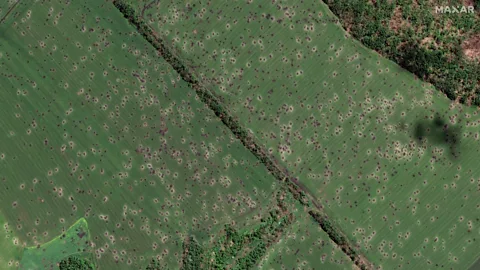 Maxar Technologies / Getty Images
Maxar Technologies / Getty ImagesEnvironmental groups are already carefully documenting the damage so that they know where to direct rehabilitation and clean-up efforts once the conflict ends. But can Ukraine’s crops and desecrated soil be recultivated? No one can say decisively at this point, but experts agree that it will involve a mammoth effort and that it will not be a one-size-fits-all solution, as the contamination is location-specific. Clean-up efforts may involve using microbes to break down oil spills, or growing plants such as brake fern and sunflowers to extract certain toxic chemicals or stabilise the soil.
Some of Ukraine’s worst-hit areas are in the southern and eastern parts of the country, which also had the most fertile soil, says Yevhenia Zasiadko, head of climate at EcoAction, a Ukrainian non-profit that is building a database documenting the environmental impacts of Russia’s war. To date, EcoAction has documented 841 incidents, using open-source data.
Mines or missiles, fuel and lubricants from military vehicles, and combustion products are all resulting in chemical contamination of Ukraine soils, says Zasiadko. “Harmful substances can migrate into the plants growing on that land, so food can become poison for those who consume it,” she says.
Sensory Overload
From the microplastics sprayed on farmland to the noxious odours released by sewage plants and the noise harming marine life, pollutants are seeping into every aspect of our existence. Sensory Overload explores the impact of pollution on all our senses and the long-term harm it is inflicting on humans and the natural world. Read some of the other stories from the series here:
When a range of munitions have been used, soil toxicity can be persistent and challenging to remove so locations must be prioritised depending on the level of damage, says Hinwood. Excessive bombing in places like Mariupol, a port city with multiple types of industry and urban development, poses enormous challenges in terms of crop remediation, she says. “If you have damage to urban infrastructure, wastewater infrastructure, maybe chemical manufacturing plants, you’ve got multiple environmental impacts there,” she says.
But with so many lives shattered by the conflict, it may be difficult to ensure enough attention is paid to the long-term environmental costs the war is creating, says Zasiadko. She hopes contaminated soils won’t be ignored after the war. “We need to keep this on the agenda. [Conflict pollution] is not visible. Even if the war would stop now, [we’d face] consequences with the environment for years and years; we need to deal with this.”
She says currently “there’s not much information about how the government are going to act”. Ukraine’s ministry for environment did not respond to BBC Future’s request for comment.
In terms of remediation, Zasiadko hopes that some of the most damaged areas will be assigned as nature conservation zones and allowed to recover. “[But] everything has to be decided individually, and depends on the level of pollution and what it will be used for,” she says.
Monitoring is critical to direct remediation efforts to the highest priority sites, says Wim Zwijnenburg, a senior researcher working on environment and conflict for Pax, a Dutch non-profit peace organisation. Pax has been using satellite images and open source data to identify and map pollution incidents, including 213 reported military actions on energy infrastructure.
Although contamination is harder to detect without soil analysis, Zwijnenburg says sustained shelling of a certain area would indicate that the soil is saturated with military-origin metals and munition constituents such as the toxic explosive chemical TNT that could warrant further investigation.
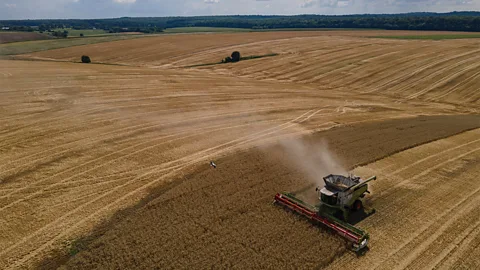 Alexey Furman / Getty Images
Alexey Furman / Getty ImagesDuring wartime, when there’s no waste management infrastructure, waste piles up in unregulated or informal landfills on the outskirts of towns and cities, says Zwijnenburg. “Then leachate from household waste gets into the soil and groundwater because no one is collecting the waste anymore,” he says. If underground infrastructure becomes damaged during conflict, raw sewage or untreated wastewater can be released into the soil. And without the usual infrastructure, chemical waste may get illegally dumped by industry, warns Zwijnenburg.
As Marcos Orellana, the UN Special Rapporteur on toxics and human rights, explains, “armed conflict is an amplifier [of pollution]”.
“It undermines the ability of the state to effectively control hazardous substances and waste in the territory and all of that results in increased contamination and increased exposure of people to hazardous substances,” he says. “Everyone has the right to live in a non-toxic environment.”
Once in the environment, pollutants can pose a serious risk to human health and be difficult to remove.
Three and a half decades after the 1986 Chernobyl disaster, crops in the area are still contaminated with radioactivity and the current conflict is exacerbating the situation. If contaminated soils are disturbed, by heavy traffic, troops digging trenches or artillery rounds, “there’s always potential for more of that contamination to end up being more widely distributed”, says David Santillo, a scientist at the Greenpeace Research Laboratories at the University of Exeter in the UK.
“Radioactive substances will be around for tens of thousands, if not hundreds of thousands, of years because they just decay so slowly and remain a problem for all of that period – you really don’t want to spread them around,” he warns.
Other contaminants of concern in Ukraine are uranium and arsenic. According to UNEP, pre-conflict studies indicate significant contamination, including arsenic, in and around mining operations in the Donbas region, and also around uranium mining and processing sites. UNEP warns that the risk of this existing contamination spreading due to lack of management and oversight may be exacerbated by the conflict, but until further sampling and analysis has been carried out, nobody knows the true extent of this.
Depleted uranium found in armour-piercing shells and tank armour can have serious after effects and hinder clean-up efforts, according to UNEP. Once weapons hit the ground, they often remain buried so uranium takes decades to dissolve into the soil. In mammals, that uranium toxicity can impact brain development, behaviour and kidney function. In addition to radioactive properties, soluble compounds of depleted uranium also become concentrated in the kidneys when ingested in food and drink. One of the most intense forms of exposure can occur after a war has ended, when children play on old army vehicles and tanks, ingest or inhale contaminated dust from explosions or workers deal with the metal at scrap yards. Depleted uranium can be transferred to the unborn foetus via the placenta and an in-depth study of more than 8,500 pregnant women in China associated exposure to a higher risk of preterm birth.
Radioactive isotopes around Chernobyl are also being drawn up by trees. “Trees are very good, unfortunately, at putting their roots down into contaminated soil layers and drawing up those radioactive contaminants into the wood,” says Santillo. “When people collect and burn wood, that contamination gets dispersed even more widely in the ash that gets released.”
Trees also pump up contaminants into their leaves and when those eventually drop off, any contamination is redistributed back into the soil. “Conflict is likely to cause more fires, likely to lead people to be more directly exposed to the soil, and increase the foraging for wood in the area,” says Santillo. “It’s pervasive. You’ve got to wait for some things to decay and of course take measures to protect people and animals by keeping them away from areas, or by not using wood or crops form certain locations. But when you get conflict superimposed on top of that, it starts to produce a level of chaos and lack of control that means that determining what’s gone on, and who has been exposed to what, becomes extremely difficult.”
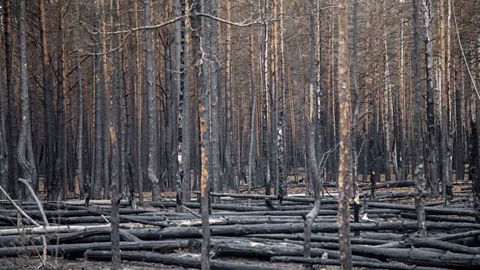 Narciso Contreras / Getty Images
Narciso Contreras / Getty ImagesSoil pollution caused by warfare leads to many different problems, says Ganga Hettiarachchi, a soil chemist at Kansas State University. “It’s not just chemical; it’s physical, biological too. Soils can be impacted for decades or longer because of [conflict].” The use of heavy machinery and equipment can compact the soil and damage the ecosystem of microbes living within it, even without an chemical contamination, she says. Well-structured soil with air pockets and space for water to drain, along with a diverse and thriving microbiome, are required for healthy and productive crop growth.
Soil testing is key to working out exactly what’s there and in what concentrations, for each situation, says Hettiarachchi. Once the cocktail of contaminants has been identified and analysed, a long-term plan to deal with them must be developed. “We can definitely find solutions,” she says.
But phytoremediation is “definitely not a short-term solution”, warns Hettiarachchi, adding that it could take 20 years or more to remediate soil using this method.
For certain contaminants, such as heavy metals, other solutions are needed, she says, as plants don’t tend to build up significant concentrations. This is because heavy metals are rapidly adsorbed by soil or might concentrate in the roots but not move up to the plant shoots, she explains.
So it could take “a very long time, perhaps 200 years” to extract heavy metal contaminants from the soil through multiple harvests, says Hettiarachchi. “When we think about phyto-extraction, we want plants to [ideally] be taken up into shoots so we can harvest this biomass, then perhaps burn it so that the metals are concentrated into a small volume and then destroyed.” But capturing all of the fly ash would be impossible so if the biomass is radioactive, it needs to be securely contained somehow, warns Santillo.
 Wolfgang Schwan / Getty Images
Wolfgang Schwan / Getty ImagesRadioactive substances could be removed from the soil using a process known as liming, the spreading of calcium-rich chalk or limestone onto the surface of the soil to lower the acidity before ploughing. According to Santillo, this could potentially reduce the transfer of radioactivity from soil to crops and a centralised disposal service could be introduced for radioactively contaminated ash that is currently still used as crop fertiliser. But there’s no way to eliminate it entirely because the toxicity is so diffuse and far-reaching, he says.
Solutions aimed at tackling warfare contaminants must not only focus on clean-up efforts but also on the design, manufacturing, testing and use of weapons, which should involve “thinking about how [certain chemicals] might persist in the environment”, says Orellana.
It’s crucial to look at the entire life cycle of chemicals and waste, he says. “There’s not only the legacy of armed conflict as a physical manifestation on the battlefield but all the environmental impacts that armed conflict entails.”
The UN, meanwhile, is working with Ukrainian officials to deliver training programmes, gather more evidence and establish laboratories that can assess land contamination. That must all be in place before recovery can be addressed, says Hinwood.
“When this conflict is over, we want to build back greener, in a way that supports both the environment and human health,” she says.
[ad_2]
Source link





